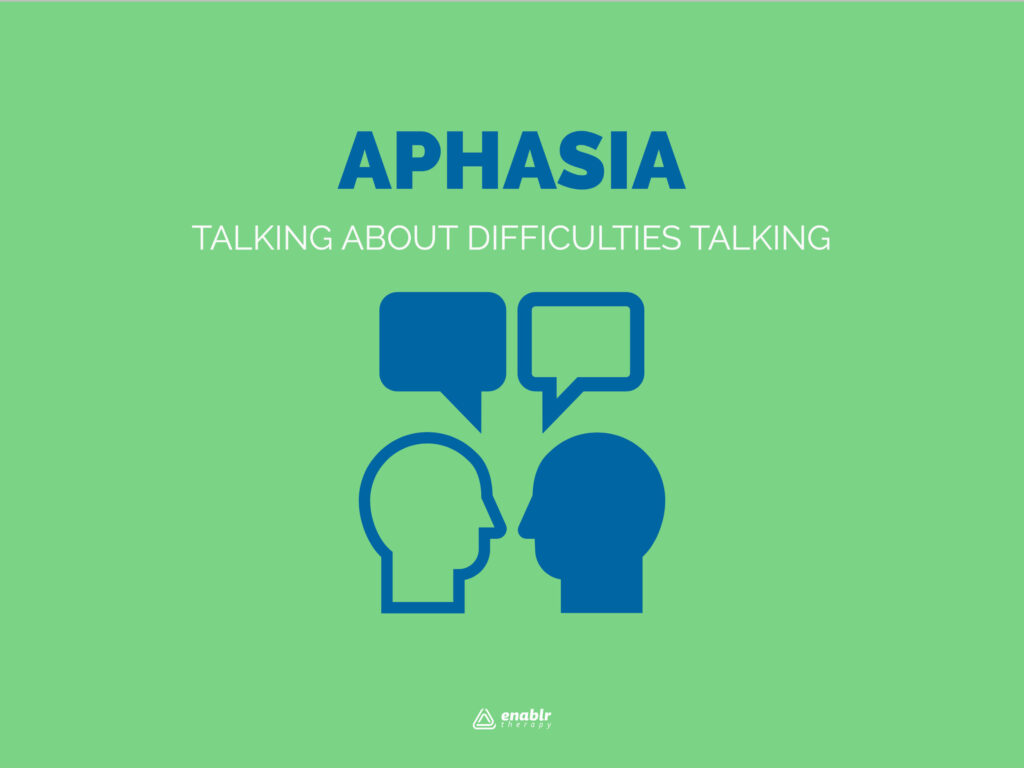
Small talk, big talk, smooth talk, fast talk, back talk, straight talk, and all of the other kinds of talk add to our lives as we strive to understand our world, express our wants, needs, and desires, and build relationships with those around us. However, sometimes an injury or illness can impact our understanding and use of language. When this occurs, it is called Aphasia, a language disorder that affects a person’s ability to communicate. It can impact speaking, understanding, reading, and writing, making everyday interactions challenging. Understanding aphasia is crucial for providing effective support and therapy to those affected by it.
What is Aphasia?
Aphasia is a condition resulting from damage to the parts of the brain that are responsible for language. It most commonly occurs after a stroke but can also result from head injuries, brain tumors, infections, or neurodegenerative diseases. Aphasia can vary greatly in severity and type, depending on the location and extent of the brain damage.
Types of Aphasia
There are several types of aphasia, each with distinct characteristics:
1. Broca’s (Non-Fluent Aphasia)
Broca’s aphasia is characterized by difficulty in producing speech. Individuals with this type of aphasia may speak in short, halting sentences and struggle with grammar. Their comprehension is relatively preserved, allowing them to understand others better than they can express themselves.
2. Wernicke’s (Fluent Aphasia)
Wernicke’s aphasia involves fluent but often nonsensical speech. Individuals may produce long, complex sentences that lack meaning and include invented words. Their comprehension is significantly impaired, making it difficult for them to understand spoken or written language.
3. Global
Global aphasia is the most severe form, involving extensive damage to the brain’s language areas. Individuals with global aphasia have significant impairments in both comprehension and expression, often struggling with even the simplest communication tasks.
4. Anomic
Anomic aphasia is characterized by difficulties in finding the correct words, especially nouns and verbs. Individuals with anomic aphasia can produce grammatically correct sentences but often pause frequently as they search for the right words.

Causes of Aphasia
Aphasia typically results from damage to the left hemisphere of the brain, which is responsible for language in most people. The most common cause is a stroke, which can disrupt blood flow to the brain and cause cell death in the affected areas. Other causes include:
- Traumatic Brain Injury (TBI): Physical damage to the brain from an external force.
- Brain Tumors: Growths that can affect brain tissue and function.
- Infections: Conditions such as encephalitis that cause inflammation of the brain.
- Neurodegenerative Diseases: Disorders like Alzheimer’s disease that progressively damage brain cells.
Impact of Aphasia on Daily Life
Aphasia can profoundly affect an individual’s ability to perform everyday activities. Communication difficulties can lead to frustration, social isolation, and emotional distress. Relationships, employment, and overall quality of life can be significantly impacted. However, with appropriate intervention and support, individuals with aphasia can improve their communication skills and lead fulfilling lives.
Speech Therapy for Aphasia
With speech therapy, the goal is to help individuals regain as much of their communication ability as possible. Speech therapy for aphasia involves personalized treatment plans that focus on the individual’s specific needs and strengths. Some key approaches include:
- Language Exercises: Structured activities to practice speaking, understanding, reading, and writing. These exercises are designed to improve specific language skills.
- Communication Strategies: Teaching alternative ways to communicate, such as using gestures, drawing, or communication devices.
- Group Therapy: Providing opportunities to practice communication in a social setting, which can enhance motivation and reduce feelings of isolation.
- Family Involvement: Educating family members on how to support their loved one’s communication efforts and creating a supportive environment at home.
Tips for Communicating with Someone with Aphasia
Effective communication with a person who has aphasia requires patience and understanding. Here are some tips:
- Use Simple Language: Speak in short, clear sentences and avoid complex language.
- Be Patient: Allow extra time for the person to respond. Do not rush or interrupt them.
- Use Gestures and Visuals: Supplement speech with gestures, facial expressions, and visual aids.
- Confirm Understanding: Gently repeat or rephrase what you said to ensure understanding.
- Encourage and Support: Offer positive reinforcement and encouragement to boost confidence.
Aphasia is a challenging condition that affects many aspects of an individual’s life. Through personalized therapy, effective communication strategies, and the support of loved ones, individuals can make significant strides in their journey toward better communication. If you or a loved one is affected by aphasia, seeking the help of a speech-language pathologist is an important step toward recovery and empowerment.
Enablr Therapy has a team of talented speech language pathologists who can work with you or your loved one to address language concerns. Enablr therapy offers speech, occupational, physical therapy, and social work services to people of all ages and abilities through school-based therapy services or online individual sessions. View our Therapy Services page to learn more.


